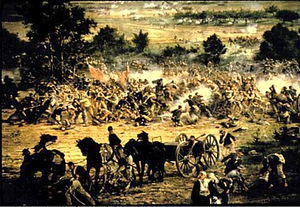A couple of days ago, I came across a reference to Louis Le Prince who was the inventor who had been credited as being first to create a motion picture. I put a link up on my Facebook TechAlmanac to his two-second, 1883 film entitled "Roundhay Garden Scene." I started reading a little more about Le Prince and learned that he had emigrated from France - first to England and then to New York - in the mid-1880s. One of his jobs was to manage the Monitor and Merrimac Panorama exhibition. I had never heard of a cyclorama so I started doing a little investigating. What I found was a fascinating history of a form of entertainment that mesmerized those in the late 19th century who saw such a display.
Panoramas (also interchangeably called Cycloramas) were gigantic paintings that were displayed inside specially-constructed round buildings so that the painting completely surrounded the viewer. The painting could be 350 to 400 feet in circumference and 25 to 40 feet high. The viewers would typically climb stairs to a high platform in the center of the building so that their viewpoint was that of being on a high hill. Often, the panorama was also combined with real foreground elements such as trees, fences, or (if it was a military scene) cannons and other armaments. The illusion of being in the painting was said to be overpowering.
The cyclorama was patented by and Englishman named Robert Barker in 1787. Barker was the first to coin the term panorama from which the adjective "panoramic" entered the lexicon in 1813. Barker's first panorama was a view of Edinburgh. He later displayed a second panorama of London as seen from the roof of Albion Mills and it was wildly successful. Hundreds more such scenes followed by other artists and were displayed across England and Europe.
In the United States, the first panorama was painted by John Vanderlyn in 1818 and was entitled, "A View of the Palace and Garden of Versailles". The painting was originally displayed in a special building in New York City called the Rotunda. The panorma has survived and is now housed in a round hall at the Metropolitan Museum of Art. It is one of only three historical panoramas that can still be seen in this country.
 |
| Paul Phillippoteaux |
 |
| A Portion of the Gettysburg Cyclorama |
The third existing historical cyclorama is titled "The Battle of Atlanta" and is on display in Atlanta, GA. While this battle depicts the North's victory in Atlanta, it is still cherished as a reminder of the Confederacy's resistance to the decimation of Atlanta by General William Tecumseh Sherman.
There were many more of these huge paintings that were shown in traveling displays to hundreds of thousands of people. Some titles included "The Battle of Shiloh", "The Battle of Second Manassas", and (the one that got me going in the first place) "The Battle of the Monitor and Merrimac". You might think that it would be hard to lose paintings this large. After all, the combined paintings making up the cyclorama usually weighed about 10,000 pounds and, even rolled up, would have been 30 to 40 feet long. Some were lost to fire, others were undoubtedly thrown out when the fashion for these paintings passed. Still others were cut up to make smaller paintings for framing.
One interesting footnote came to light almost in my backyard. An artist named Joseph Wallace King of Winston-Salem, NC became obsessed with finding one of the missing Battle of Gettysburg cycloramas and stayed on the hunt for decades. In the 1960s, he got word that one of them might be in a warehouse in Chicago. When he went to the location, he was told that the old warehouse had burned down a few years before but he went in to the new one and found a fire-blackened back wall. For whatever reason he thought there might be something behind the wall and talked the owner into letting him punch a hole through to check. Behind the wall lay one of the stored copies of the Gettysburg cyclorama. He bought the painting and brought it back to Winston-Salem and unrolled the paintings end to end in the Bowman Gray football stadium. They even had to take the goal posts down to put all the pieces end to end. King died in 1996 while trying to get the paintings restored and redisplayed. He bequeathed the cyclorama to Wake Forest University. In 2007, three unidentified investors from Raleigh bought the painting from the University for a reported $10 million and are seeking other investors to restore and display it.
Cycloramas were the IMAX of their day. They provided a spectacle and an immersive experience that took viewers to other places and other times. In the days before motion pictures, they must have been truly extraordinary. But like every technology, these massive paintings became a dated form of entertainment. The painting that was found in the old Chicago warehouse was last displayed at the Chicago World's Fair in 1933 and was a Midway attraction, not even one of the major exhibits.
I wonder what the next century will bring in immersive experience. With the rate of acceleration of virtual reality software it is likely that we will get to the point where we will be able to inhabit places indistinguishable from the real world. We are almost there now. I can imagine a future virtual theater recreating an even more powerful rendition of the Battle of Gettysburg. On the other hand, there have been so many battles since that epic conflict that it might be hard to chose which battle to recreate.
Further reading:
Saving the IMAX of its Day - American Heritage Magazine
The Velaslavasay Panorama
Official Website of the International Panorama Conference with lists of other panoramas by country.

No comments:
Post a Comment